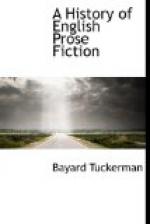Bulwer Lytton’s “Last Days of Pompeii,” and “Harold, the Last of the Saxon Kings,” are both powerful, ingenious, and interesting narratives, and they give as definite an idea, perhaps, of the times of which they treat as is possible after so long a lapse of time. “Rienzi” leaves a greater impression of verisimilitude. “The Last of the Barons” is somewhat clogged by its superabundance of historic incident, but still affords a striking view of declining feudalism. In the “Tale of Two Cities” and “Barnaby Rudge,” Dickens described the sanguinary scenes of the French Revolution and the Lord Gordon Riots with his never-failing power. Since the Waverley novels, the most perfect specimen of English historical fiction has been “Henry Esmond.” The artistic construction of its plot, and the life-like reality of its characters, place it first among Thackeray’s works. But its pre-eminence among historical novels is due to the fact that it reproduces so vividly the spirit and atmosphere of a past age. All the thoughts, opinions, and actions of the characters in “Henry Esmond” are such as we should expect from persons living in the beginning of the eighteenth century. Whoever is familiar with the pages of the “Spectator” will notice how faithfully Thackeray adopted the language of Steele and Addison. It is true that he had a far less difficult task before him in describing the age of Queen Anne than fell to the lot of Bulwer Lytton in “The Last Days of Pompeii.” The latter work required far more historical research and a far greater effort of the imagination. But while in Lytton’s novel the reader cannot divest himself of a certain sense of unreality, he feels that “Henry Esmond” really carries him back to the period it portrays.
George Eliot’s “Romola” must always retain a high place in historical fiction. But its author’s great creative power led her to bestow more pains on such of the characters as proceeded from her own imagination, than on those whom history provided ready-made. The reader’s memory retains a more vivid impression of Tito than it does of Savonarola. Charles Kingsley’s “Hypatia” and “Westward Ho!” are among the most prominent of recent historical novels. The latter aimed at describing the time of Elizabeth, but resembles more closely that of Cromwell. John Gibson Lockhart, in “Valerius,” and Mr. Wilkie Collins in “Antonina,” have studied the life of ancient Rome. James Fenimore Cooper in “The Spy” and “The Pioneers” threw into bold relief the stirring incidents of American colonial and revolutionary times. Nathaniel Hawthorne reproduced the spirit of Puritan New England in “The Scarlet Letter,” of which mention has already been made.




